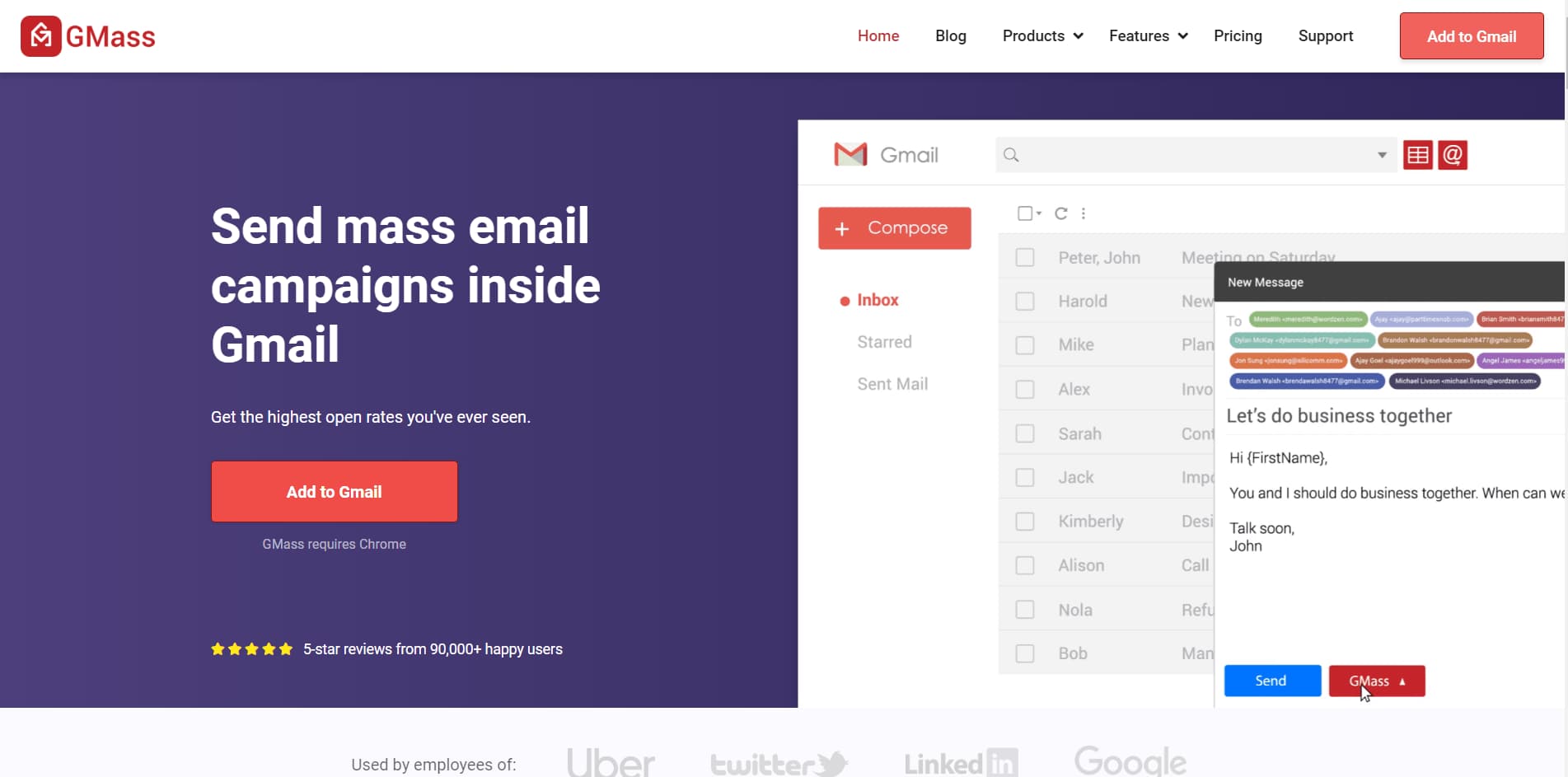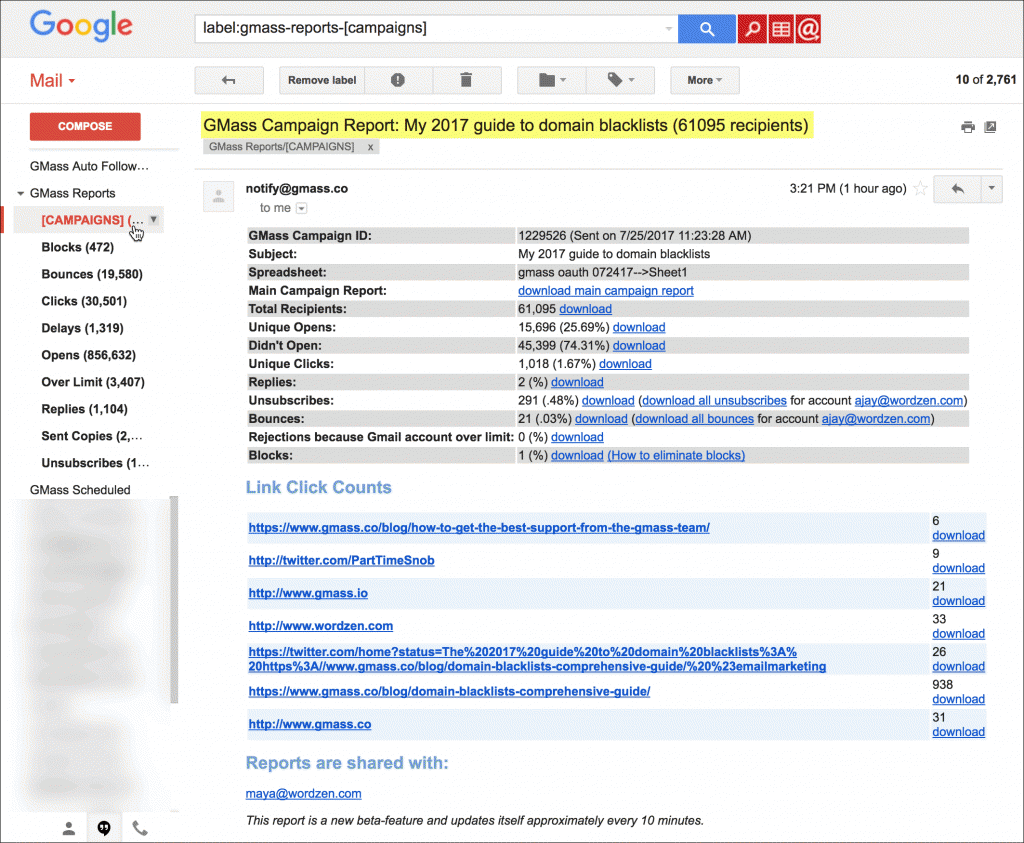
Want to understand email deliverability?
Email deliverability represents the percentage of total emails you send that successfully reach the recipients’ inbox and don’t get caught in spam filters.
In this article, I’ll describe everything you need to know about email deliverability. I’ll discuss what it means, why email inbox placement matters, the factors that affect it, and how you can easily improve email deliverability.
This Article Contains:
(Click on a link to jump to the specific section.)
- What Is Email Deliverability?
- Why Does Email Deliverability Matter?
- How Do You Boost Email Deliverability?
- What Is a Good Email Deliverability Rate?
- What Affects Email Deliverability?
Let’s jump right into it.
What Is Email Deliverability?
Email deliverability is your ability to send emails that reach a recipient’s inbox. It’s a standard email performance metric used to evaluate email marketing effectiveness.
To understand it better, let me ask you something:
What’s your most important goal as an email marketer?
It’s probably to send relevant content to subscribers in hopes of converting them into customers, right?
Now, let’s say you spent a lot of time creating a subscriber list from the ground up. And you spent hours creating engaging content for your audience.
However, if your emails don’t reach your customer’s inbox after everything, all that effort would’ve been for nothing!
That’s one reason email deliverability is always one of the most important factors to consider — especially when comparing different email marketing software, SMTP service providers, and email API services.
Wait, what’s SMTP and email API?
An SMTP (Simple Mail Transfer Protocol) service lets you bypass the sending limits of your email service provider (ESP).
For example, a regular Gmail account has a sending limit of up to 500 emails/day. However, with an SMTP service provider, you can send unlimited emails from Gmail without getting your account suspended.
To know more about SMTP, read my ultimate guide.
On the other hand, an email API service provider lets you access the capabilities of an email marketing tool directly from your website, web app, or mobile application.
Why Does Email Deliverability Matter?
The most obvious importance of deliverability is that your emails avoid the spam folder. If your recipients don’t even receive an email, there’s no point in talking about subscriber engagement.
But there’s more.
A good deliverability rate is also helpful for your reputation as a sender. Conversely, if too many of your emails trigger spam filters, this damages your sender score, leading even more spam filters to block your emails. This becomes a vicious cycle of diminishing deliverability scores.
Since email deliverability is vital to your email marketing strategy, it’s important to evaluate your email deliverability level continuously.
How Do You Measure Email Deliverability?
The email deliverability rate represents the percentage of sent emails that have successfully reached the recipients’ inbox.
To calculate it, take the ratio of the total number of emails received in inboxes to the total number of emails sent, and multiply it by 100.
Email deliverability = (Total number of emails placed in inbox / Total number of emails sent) * 100
However, to determine your email deliverability or inbox placement rate, you first need to know the actual number of emails that end up in your recipient’s inbox.
And that’s where an email marketing tool like GMass comes in handy.
What’s GMass?

GMass is an easy-to-use, robust email marketing tool that works right inside Gmail.
Its superior outreach capabilities and features for personalizing mass email content make it a popular tool used by employees of global powerhouses like Google, Uber, Twitter, and LinkedIn.
It’s also perfect for small businesses, churches, solopreneurs, and pretty much anyone else who uses Gmail!
How does GMass help measure email deliverability?
GMass’ advanced analytics auto-generates a Campaign Report each time you send an email campaign.
It tracks several core email engagement metrics, like:
- Total recipients: total number of email addresses to which the campaign is sent
- Bounces: total number of emails returned as undelivered because the addresses were invalid
- Unique opens: total number of unique email addresses that opened your email
- Didn’t open: total number of email IDs that didn’t open the email
- Replies: total number of subscribers who replied to the email
- Unsubscribers: total number of users who clicked the unsubscribe link in the email
- Blocks: total number of email addresses that came back undelivered because the addresses rejected your email as spam
- Rejections because Gmail account is over its limit: total number of emails that were undelivered because Gmail restricted your account’s sending ability
You can quickly calculate email deliverability as follows:
Email deliverability = (Total Recipients – Blocks – Bounces) / Total Recipients

The report offers a comprehensive outlook on the campaign’s performance, showing you everything — from the number of emails opened to the total number of bounced emails.
But that’s not all!
GMass checks your SPF record before you send a campaign to make sure it’s not missing or incorrect.
GMass’ “Inbox, Spam, or Promotions” email delivery tester lets you check whether your emails are reaching the inbox, spam, or promotions folder. The tool helps you see where your own (or everyone else’s) emails are landing.
Read my article on using the “Inbox, Spam or Promotions” tool for more info.
Moreover, my free Domain Deliverability Statistics Tool helps you find out the delivery statistics and bounce codes for any domain, like Gmail or Yahoo. Search for any domain name, and discover the send, open rates, and bounce rates across any time range.
To know more, read my article on the Domain Deliverability Statistics tool.
How Do You Boost Email Deliverability?
Sure, high email deliverability is essential.
But how do you increase it?
Here are some smart techniques that will help improve your email deliverability and reach more customers:
1. Maintain a Clean Mailing List
A clean mailing list helps you minimize your bounce rate.
Generally, a mailing list is clean as long as it doesn’t include:
- Spam trap addresses.
- Non-existent users.
- Inactive subscribers.
That’s why it’s important to remove such list entries and perform regular subscriber list segmentation.
How does GMass help here?
When a recipient unsubscribes from your mailing list, their email address is automatically moved from your mailing list to the GMass account’s Unsubscribe list.
Additionally, with GMass, you can build mailing lists right inside Gmail.
Simply use the Email List Builder feature to find email IDs deep within your Gmail account.
Here’s how to use the feature:
- Search for a particular keyword in your Gmail account’s search bar.
- GMass will display a list of everyone who has mentioned that term in their emails to you; then click on the Build Email List button to select them all.
- GMass auto-builds an email list using the IDs found in your search list.
- After that, a Compose window is displayed that contains those recipients in the To field.
- You can now send campaigns to this mailing list.
Once you’ve created a send list, GMass auto-saves it so that you can easily resend campaigns to the same set of people anytime.
To learn more, read my article on how to build an email list from your Gmail account.
2. Send Email Campaigns at the Right Frequency
When sending out email campaigns, being regular is a good thing, but being far too frequent can be harmful.
Why?
If you’re someone who sends out bulk email campaigns or lots of transactional emails in bursts, you can expect your Internet Service Provider (ISP) to be strict with you.
ISPs view sudden fluctuations in sending volume with suspicion and can start restricting your email deliverability.
That’s why consistent email-sending frequency and volume is important to improve your deliverability rates and maintain a good sender reputation.
How does GMass help here?
GMass allows you to phase out spikes in your email sending volume by providing an option to increase the delay between sent emails to anywhere between 5-90 seconds.
Additionally, you can use GMass’ powerful email scheduling feature to schedule emails in advance. This way, you can send out campaigns at the right frequency without ticking off your provider.
3. Have a Good Sender Reputation
A sending domain name or IP address with a good sender reputation will generally have better email deliverability.
Sender reputation scores are calculated by ISPs to determine how much the user can be trusted not to send spam. If your domain or IP address has a high sender reputation score, ISPs will assume that your emails don’t contain spam and place your emails in the subscriber’s inbox.
If you’re sending emails from an IP with a poor reputation, your emails run the risk of not getting delivered to the inbox.
How does GMass help here?
GMass solves this by sending all emails from the users’ Gmail accounts — and Gmail’s IP addresses happen to have the best sending reputation globally.
Besides, features like the GMass Spam Solver helps you tweak your emails until they hit the inbox. Modify the subject line and headers, take out images, turn off the tracking domain, and more to ensure you’ve done everything to maximize the deliverability.
4. Set Up Security Protocols
Using security protocols like SPF, DKIM, and DMARC when sending emails increases your reputation when vetted by a mail server.
What are SPF, DKIM, and DMARC?
SPF (Sender Policy Framework) is a security standard used to define which IP addresses can send emails from a specified domain. The allowed IP addresses are listed within an SPF record.
DKIM (DomainKeys Identified Mail) is another email authentication method used to verify that an email from the sender was not forged and that no one has tampered with it.
DMARC (Domain-based Message Authentication, Reporting, and Conformance) is a security policy that checks whether an email is protected by SPF and DKIM and reports back to the sender if both security protocols were to fail.
How does GMass help here?
As you’re sending emails from your Gmail or G Suite account when using GMass, your emails are automatically SPF and DKIM compliant.
What Is a Good Email Deliverability Rate?
Let’s say the email deliverability rate of your campaign is 65%.
Is that a good or bad number?
You want a high deliverability rate, but what’s a reasonable benchmark for good email deliverability?
In 2019, the average deliverability rate was around 80%. This figure differs according to context, with deliverability rates for government websites, retail, SaaS, and blogs varying greatly.
With a service like GMass in your arsenal, you can be much more optimistic and generally attain email deliverability rates over 95%.
What Affects Email Deliverability?
If everyone knows that high email deliverability is desirable, why do emails fail to hit the inbox? What makes emails hard-bounce in the first place?
Here’s a close look at the factors that generally result in an email deliverability issue:
A. Low Sender Reputation
The most critical parameter in ensuring successful email inbox placement is probably your sender reputation.
Sender reputation represents the trustworthiness of the IP address (IP reputation) and domain (domain reputation) used to send out campaigns. ISPs may reject any emails from an email sender whose reputation falls below a certain sender score.
Most inbox provider services also check for security protocols like SPF, DKIM, and DMARC when filtering emails. These are security mechanisms used to prevent a malicious sender or spammer from sending emails on your behalf.
B. Poor Mailing List Quality
When running bulk email campaigns, you don’t send out each email individually. You maintain a subscriber or mailing list and send out bulk emails trying to reach all those addresses.
Maintaining a subscriber list is an example of permission marketing — where the audience is given a choice to opt-in to marketing emails.
However, there are a few problems that can arise with subscriber lists that aren’t updated regularly, such as:
- Spam traps used by ISPs to mimic normal email addresses and lure cold campaign senders.
- Emails being sent to addresses that don’t exist, causing your bounce rate to spike and raising flags with mailbox providers.
- Recipients reporting your unwelcome emails as spam.
Not only do these push you to the edges of a bad reputation, but ISPs and mailbox providers can also use this feedback to limit your campaign reach.
C. Lack of Engagement
A significant problem with permission marketing is that subscribers might grow unresponsive over time. This can happen when the email content you send no longer feels relevant to them.
When the number of emails opened, clicked, replied to by certain users drops, ISPs will interpret your messages as spam emails that are irrelevant and pointless.
Based on these cues, ISPs will want to limit your inbox placement even further, causing your engagement rates to go down.
D. Being Blacklisted
Getting blacklisted is every email marketer’s nightmare.
Blacklists are used by ISPs and mailbox providers to avoid spammy emails from getting to recipients. The lists contain IP addresses and domains known to send spam, and they automatically get filtered out by a spam filter.
This usually arises as a consequence of high spam complaints from accounts that didn’t willingly subscribe to your email program.
E. Difficulty in Unsubscribing
Customers unsubscribing from your mailing list lead to weaker outreach and lower conversions.
So why not make it difficult to unsubscribe and have no unsubscribe links within your emails?
After all, if people can’t unsubscribe, you still get to maintain your reach, right?
While that may sound like a viable solution, it does more harm than good in the long run.
You don’t want to force your customers to stay by not offering them a chance to leave.
If you did, here’s how it would play out:
- A customer who isn’t interested in your content wants to unsubscribe.
- There’s no easy way to unsubscribe, so the customer is forced to stay.
- Your customer keeps receiving emails from your bulk email campaign and starts getting annoyed.
- Without a convenient way to opt-out, the customer is compelled to report your address as spam.
When enough spam complaints are stacked up, the high complaint rate massively reduces the chances of your emails getting placed in subscribers inboxes.
Conclusion
Email deliverability is an important metric to consider when evaluating email marketing effectiveness.
Some mailbox providers allow you to measure email delivery, which is the percentage of sent emails that were not rejected by the mailbox provider or ISP. However, to measure the actual email deliverability rate, you need an email marketing tool like GMass.
With GMass, you can maintain a clean email list, manage phased email sending, build a good sender reputation, and be SPF and DKIM compliant automatically. GMass also comes with tons of other useful email marketing and marketing automation features to enhance your campaigns.
So why not sign up for GMass today and immediately skyrocket your email deliverability?
Only GMass packs every email app into one tool — and brings it all into Gmail for you. Better emails. Tons of power. Easy to use.
TRY GMASS FOR FREE
Download Chrome extension - 30 second install!
No credit card required










